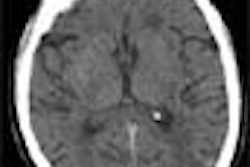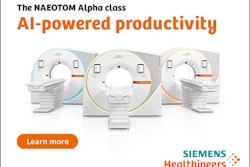CHICAGO - In patients with chronic sinusitis, CT does a good job of imaging the paranasal sinuses for use in preoperative planning. The modality offers excellent visualization of the bony details, which serve as landmarks during complex surgical procedures. Soft-tissue abnormalities such as mucosal swelling are less well depicted, however, and dental amalgam artifacts can be a problem.
Still, CT's biggest drawback may be radiation. Most chronic sinusitis patients are young, so the concern is more than academic. At Friday's neuroradiology sessions of the RSNA meeting, Dr. Florian Dammann from the University Hospital of Tuebingen, Germany, discussed the results of his group's study of 60 patients using both modalities. MRI can replace CT for preoperative planning in patients with paranasal sinus disease, the study concluded.
"No radiation is necessary for the use of MRI, and at the same time, it gives better soft-tissue contrast compared with CT," said Dammann. But, he asked, does MRI's poorer depiction of bony masses reduce its utility? How should MRI be managed in routine practice?
The researchers sought to answer these questions by comparing image quality, depiction of relevant anatomic details, and mucosal thickening with low-field MRI and low-dose CT.
All 60 patients underwent either transversal (30 patients) or coronal (30 patients) spiral CT of the paranasal sinuses, followed immediately by low-field MRI using a 0.2-tesla system.
First, the spiral CT images were acquired using a low-dose CT protocol of 100 mAs or less, 120 kVp, pitch 1.5, 2-mm collimation, and reformations performed at 2 mm.
The MRI protocol included coronal spin-echo T1- and fat-saturated T2-weighted images, as well as facultatively fat-saturated images in both sagittal and coronal views, using a head coil and 3-mm slice thickness. The scanner was a 0.2-tesla Magnetom Open system (Siemens Medical Solutions, Iselin, NJ).
"We used the low-field 0.2-tesla machine because it was uncomplicated, [there was] fast access to the machine, and ... the image quality was sufficient," Dammann said. "It should work with high-field machines as well."
Image quality was evaluated by two radiologists, and by two ear, nose, and throat surgeons who needed to be trained in MRI interpretation before the study. They rated artifacts, image quality, and depiction of anatomic details on a scale of 1 to 5, 5 being best.
"Dental metal artifacts [were] a major problem in coronal CT scans, and significantly impaired image quality in 6 out of 30 patients who received the direct coronal scan. This is different in the coronal T2-weighted MR image. There was only one patient with significant detrimental artifacts in MRI. Stairstep artifacts were present in nearly all the coronal reformations," Dammann said.
T1- and T2-weighted MRI and CT all performed equally well in imaging the osteonasal complex, which is the most important area for preoperative imaging, he said. MRI had better soft-tissue contrast, and better depicted mucosal swelling. Coronal CT was rated better than MRI in the area of the eye muscles.
In overall image quality, CT (4.55) was ranked better than MRI (3.97) due to its superior depiction of bony details. "This difference was statistically significant, but there was no clinical relevance ... because MRI provided very good image quality," Dammann said.
Mucosal pathology was rendered slightly better in MRI, but the difference between the two modalities did not reach statistical significance. In overall diagnostic value, the researchers rated MRI better than CT in 24% of patients, and inferior to CT in 41% of cases.
"In conclusion, we can say that MRI image quality is slightly inferior to CT, but equals CT for clinically relevant diagnosis. MRI is accepted by ENT surgeons, and it can replace CT in chronic sinusitis."
In response to questions following the talk, Dammann said the two ENT surgeons were trained in MRI image interpretation before the study, but said their lack of previous experience with MRI may have affected their ratings of the modality.
By Eric BarnesAuntMinnie.com staff writer
December 4, 2001
Related Reading
Significant difference in radiation dose found between single- and multislice CT, November 25, 2001
CT sees growth, and new concerns over radiation dose, November 25, 2001
Low-dose CT touted for oft-needed sinus imaging, February 30, 2000
Copyright © 2001 AuntMinnie.com




















